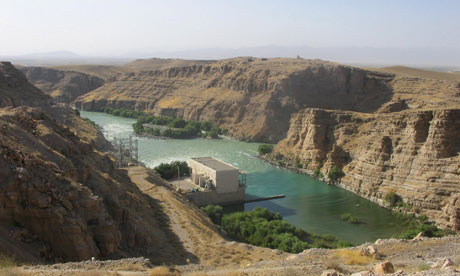Convoy diverted British troops from front but generator may never be used
by Jon Boone in Kabul
 Two thousand British troops took part in the mission to deliver 220 tonnes of equipment to the Kajaki dam, pictured. Photograph: Bronwen Roberts/AFP/Getty Images
Two thousand British troops took part in the mission to deliver 220 tonnes of equipment to the Kajaki dam, pictured. Photograph: Bronwen Roberts/AFP/Getty Images
An enormous hydroelectric turbine dragged at huge cost by British troops through Taliban heartlands last year may never be installed because Nato has been unable to secure a 30-mile stretch of road leading to an isolated dam in northern Helmand.
The daring mission to deliver 220 tonnes of equipment to the Kajaki dam in Afghanistan in September 2008 was hailed as one of the biggest success stories of the British Army's three-year deployment in Helmand.
Two thousand British troops took part in the five-day convoy through enemy territory, which was launched because the main road leading to the dam was too vulnerable to Taliban attacks.
Senior British officers privately say the enormous diversion of scarce military resources for the operation allowed the Taliban to make major gains in other critical areas of the province, including Nad Ali, which subsequently saw some of the most intense fighting between British forces and insurgents.
Within a couple of months of the Kajaki operation, areas close to the British base in Lashkar Gah had deteriorated so badly that troops had to be resupplied by air drop.
The dam continues to be besieged by Taliban fighters and, 15 months after the mission by the UK troops, the turbine's components remain unassembled because huge amounts of cement that are required to install the equipment cannot be delivered safely.
Now the United States Agency for International Development (USAID), the wing of the United States government which has so far pumped $47m (£29m) into the project, intended to electrify much of southern Afghanistan, says it is packing the turbine parts away and looking for other energy projects to invest in across Afghanistan.
"Our message is that until we have a secure road we cannot continue with the installation of turbine two," said John Smith-Sreen, head of energy and water projects for USAID in Kabul.
"When the turbine was moved in by British and American forces it was a huge effort and it was done in a point of time. But we can't move in the large quantity of cement and aggregate that we need in a point of time, we need a sustained effort," he said.
The road would need to be secured for about half a year.
http://www.guardian.co.uk/world/2009/dec/13/afghanistan-turbine-taliban-british-army








No comments:
Post a Comment